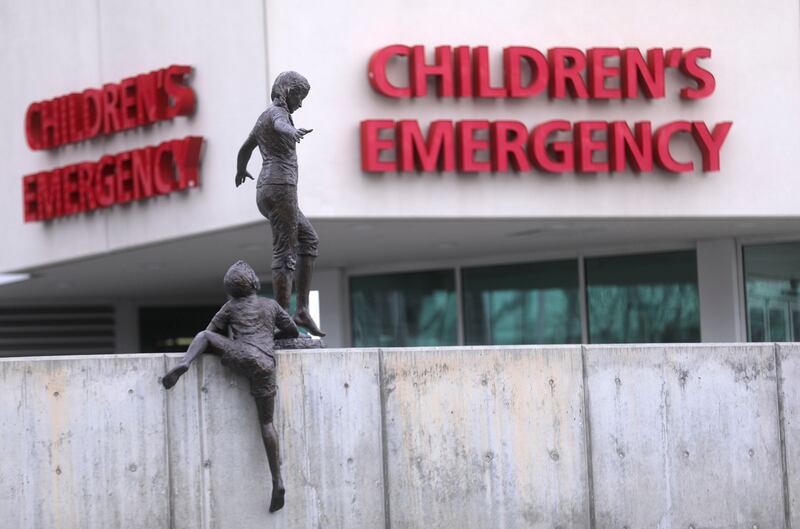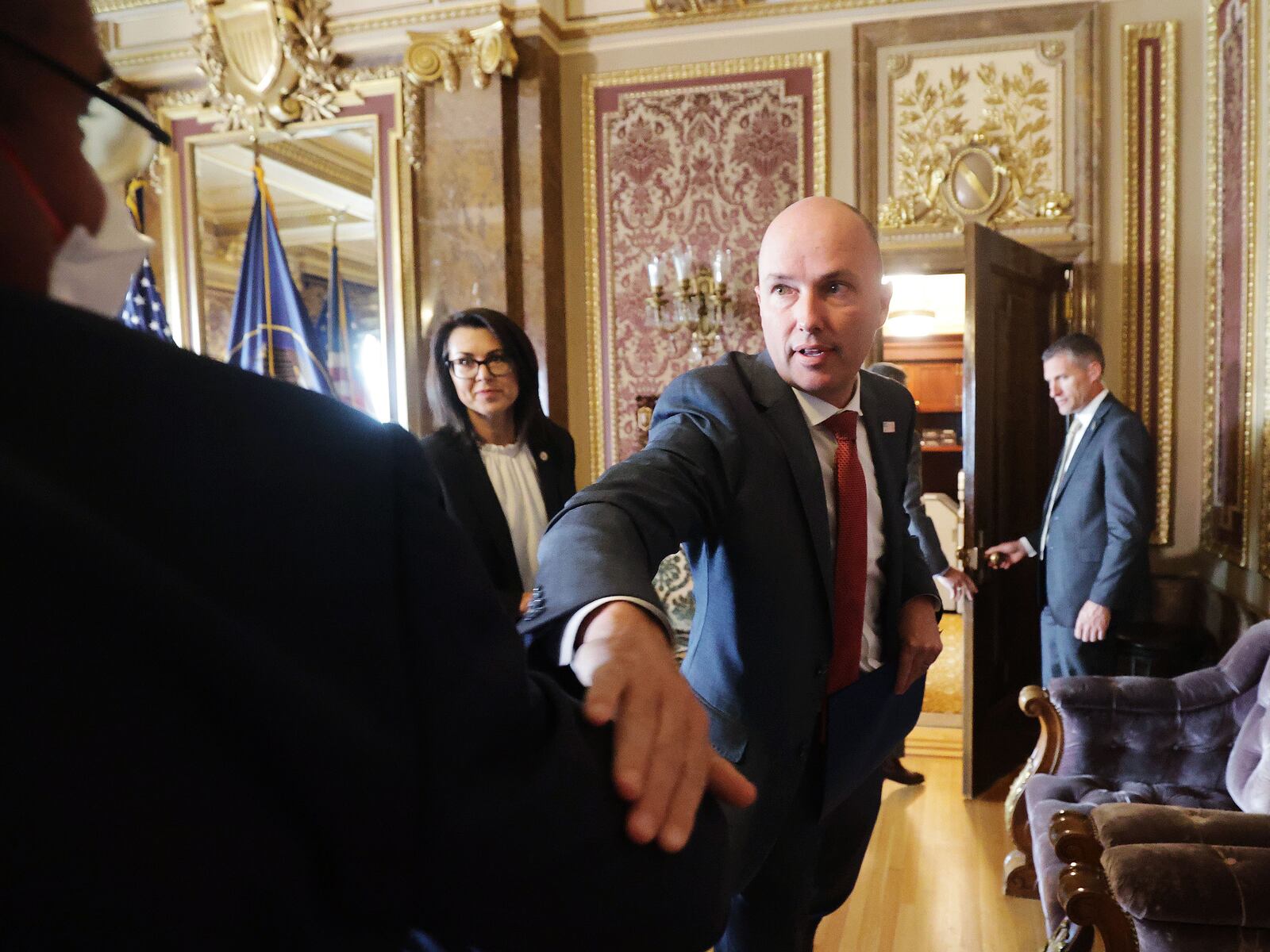Utah's COVID-19 cases in school-age children are 3.5 times higher at the beginning of this school year than last, one top health official said Tuesday.
And statewide projections show Utah is in for a devastating start to fall if residents don't resume mask-wearing and get vaccinated, Dr. Michelle Hofmann, deputy director at the Utah Department of Health, said during a news conference with Gov. Spencer Cox and other leaders at the state Capitol on Tuesday.
The rolling seven-day average for positive coronavirus cases is now 1,263 cases per day. That's up from 795 per day just one month ago, Hoffman noted.
And projections show cases are "increasing dramatically" over what schools experienced last fall. She said the state is projected to see up to 39,000 cases during September alone.
"We've said it before. All models are wrong, but even in the range, our model is alarming, with between 25,000 and 63,000 cases in September," Hoffman said.
Cases in children
The expected ongoing surge comes as the school year has begun amid a "higher level" of spread, the delta variant that accounts for most of the new cases is five times more transmissible than other variants "and we have almost no masks in schools this year," Hoffman said.
Only 38.1% of children ages 12-17 are fully vaccinated against COVID-19, she said, and no health district has more than 60% of that age group vaccinated. Four health districts have fewer than 20% vaccinated.
"We know kids are very unlikely to get seriously ill, but the sheer amount of transmission turns that small percentage into a fairly large number of hospitalizations. We also know that kids are very good spreaders, and even if they don't get sick, they take their infection home to those who may be more vulnerable," she said.

Chris Miller, chief marketing officer at Primary Children's Hospital, said the hospital averaged zero patients with COVID-19 in May. Three weeks ago, it started to see three to four patients every single day with COVID-19. That average jumped to seven to nine children on any given day, he said.
"Combined with other Intermountain hospitals in Utah, we are now treating 12-17 children on any given day in one of our hospitals, with five to seven of those children being in one of our ICUs on any given day," Miller said.
He said those cases include some children with multisystem inflammatory syndrome, which causes severe inflammation throughout the body.
"As we speak, we are currently taking care of several patients up in Primary Children's with MIS-C," Miller said.
At the same time, RSV cases have increased, with 209 cases per week, on average — approaching peaks seen much later in prior seasons, he said.
The Utah Department of Health's coronavirus information dashboard will now include more data points regarding children and coronavirus, including monthly hospitalizations and multisystem inflammatory syndrome cases, Hoffman said.
Hospital strain
Cox warned Tuesday that Utah is at its "breaking point" in hospitalizations, leaving a critical patient over the weekend at a rural hospital with nowhere to go for the treatment they needed.
The state has fewer health care workers in the system currently, meaning previously-available beds are no longer staffed, the governor said.
And over the past three weeks, the number of hospitalizations has continued to rise along with the number COVID-19 cases.
On Friday evening, a rural hospital needed to transfer a critical patient to a hospital with the capacity to treat more serious patients. The rural hospital was denied the transfer because of shortages at multiple hospitals, Cox said.
"For the first time since the pandemic began, there were zero ICU beds in Utah's referral hospitals at that time," he said.
A bed eventually did open up at a city hospital, but the opening only lasted a few hours. That situation will become "more and more frequent" as hospitalizations rise, Cox said.

Intermountain Healthcare has experienced more Life Flight transfers in the last month than it's ever had before, as 300 patients have needed to be transferred by helicopter between health care systems, said Dr. Marc Harrison, president and CEO of the state's largest hospital system.
"While COVID is exacerbating things, there's other care that needs to go on," Harrison explained.
ICUs would normally run at about 75% capacity, he said, so patients can fluidly move in and out of units. Now, elective surgery cases are again getting delayed due to the strain.
"I will tell you that like the rest of the country, we have lost some really valuable clinicians over the past year, Some people just can't take it anymore. It has been unrelenting, the stresses that these people have faced," he said.
Data only tells part of the story, Hoffman noted, emphasizing other impacts of COVID-19, including nursing home outbreaks, mental health consequences and the statewide hospital surge.

"We know what works to curb the spread of COVID-19. All Utahns need to get vaccinated as soon as they are eligible, and all Utahns need to begin wearing masks now to put a stop to this current surge overwhelming hospitals," Hoffman said.
She said she was caring for disabled children in a nursing home when the pandemic first hit.
"The work is not over. Nearly one-third of Utah's nursing homes are currently experiencing a COVID-19 outbreak," which she said are all tied to cases in the community.
Vulnerable, elderly people living in nursing homes don't have the same protections given by vaccines, Hoffman noted.
She said health care workers experiencing the surge in hospitals care for patients "in hallways, and in closets turned to rooms" and get "beat down" by complaints.
"Our loved ones are getting hospitalized with mental health emergencies. I have one of those in my own family. I'm here to speak about things largely unspoken across Utah. COVID-19 is harming our children and families in more ways than we know. The path to healing is the end of this pandemic, and it hasn't ended yet, even if we want to pretend it has," Hoffman said.
'Stop the divisiveness,' doctor urges
Hoffman urged Utahns to "stop the divisiveness" about measures that work, including masks and vaccines.
"We need to heal together."
The end to mask-wearing came at a cost to health care workers who have struggled with the pandemic for 18 months, she said. She said the biggest thing people can do to express gratitude to health care workers is to mask up and get vaccinated if they haven't already done so.
The governor said he will meet with the full Legislature to discuss efforts moving forward. He said he has already been meeting regularly with legislative leadership over the last two weeks, but leadership cannot make decisions without the full House and Senate.
The 2021 Legislature passed a law that outlines who can make public health orders, leaving the power to order health measures beyond 30 days in the hands of county councils and commissions.
The Legislature has "the ability to overturn anything we do, and anything that is to happen beyond 30 days has to be approved by the legislative committee and then by the entire Legislature. It's been very difficult. It was easier back in January, February and March to have discussions regularly with the Legislature, as they were in session," Cox said.
Don't expect statewide mandates
Though Cox said there is no appetite for statewide mask mandate, he is mulling a pair of potential public health orders to give school districts more tools in their arsenal to clamp down on COVID-19 outbreaks — including allowing the ability to temporarily require face masks at a certain case rate threshold, the governor told the Deseret News.
Lawmakers have not held their regular interim time during the summer. Cox said he will meet with the Legislature through its caucuses in both the House and Senate, "in which we will present all of the data to them” and discuss the
"And then our hope is that we will be able to find some consensus on further measures as we move forward," Cox said, promising additional updates over the next few days.
Lt. Gov. Deidre Henderson noted that in discussions with legislative leaders, local health departments, school superintendents and others, "it's very clear that there's little appetite for any kind of statewide mandates other than what are already in place at this point."
"And it's frustrating for us, it's incredibly frustrating for us," Henderson said.
But she emphasized the measures that are in place. The state has delivered 1.2 million high-quality masks to schools throughout the state, and another 750,000 are on their way.
The “test to stay” program mandated by state law requires that students have a negative COVID-19 test to return to in-person learning if 2% of students at a school test positive for the disease.
"While we believe wholeheartedly in parent choice ... we also believe that choices have consequences, and if a parent chooses not to let their child be tested for COVID-19 if that 2% threshold has been met at their school, that parent is also choosing remote learning for their child," Henderson said.
She asked Utahns to "keep fighting this fight" so students can stay in school.
This story will be updated.


